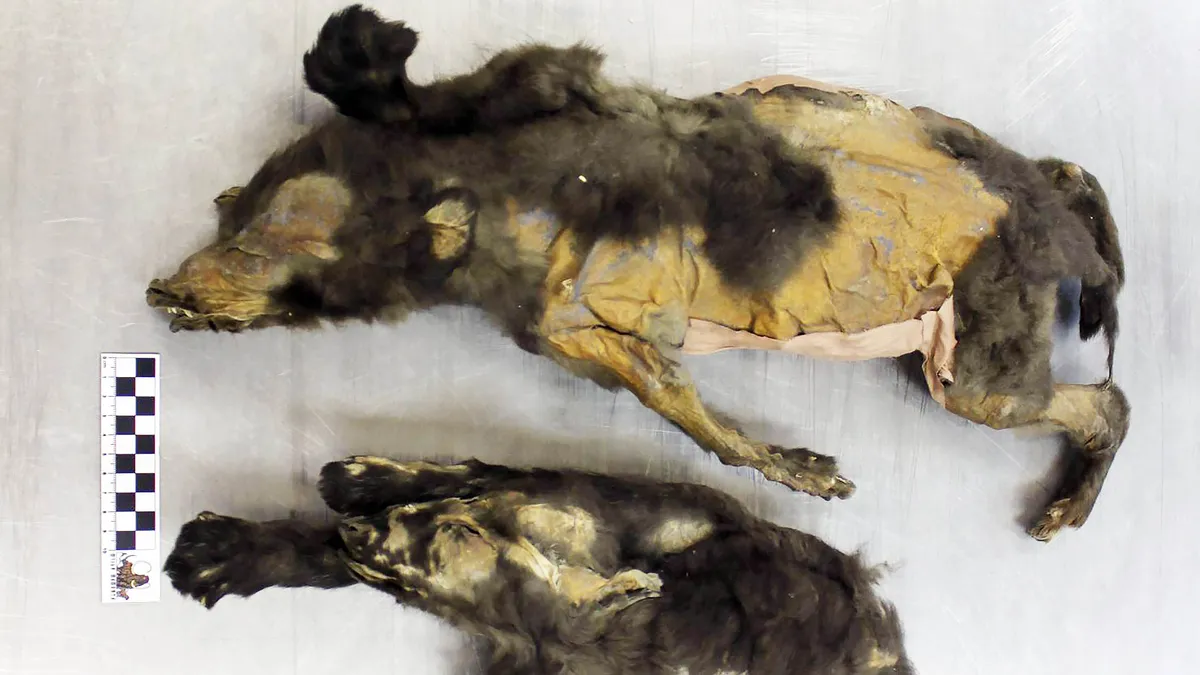
Recent findings have revealed that two small cubs, which died over 14,000 years ago, were initially misidentified as early domesticated dogs. New research confirms that these cubs were actually wolf cubs, providing significant insight into the lives of ancient canids. Discovered in northern Siberia, the remarkably preserved remains of these cubs serve as scientific time capsules, allowing researchers to explore their diets, lifestyles, and the circumstances surrounding their deaths.
The wolf cubs were unearthed approximately 40 kilometers (25 miles) from the village of Tumat in Siberia. One cub was discovered in 2011, while the other followed in 2015, at a site now referred to as the Syalakh site. Both cubs were buried deep within layers of frozen soil, preserved in permafrost alongside mammoth bones that exhibited signs of having been burned and butchered. This unique combination of ancient remains and human activity led to early speculation about the cubs’ origins, with some suggesting they might have been early dogs scavenging near human settlements. The presence of their black fur, once thought to be a characteristic unique to domesticated dogs, further fueled this hypothesis.
New research conducted by scientists at the University of York has shed light on the true identity of these cubs. By analyzing genetic material extracted from the cubs' stomachs, along with chemical signals present in their bones, teeth, and tissues, researchers were able to conclude that these were not early dogs but rather wild wolves that thrived during the Pleistocene epoch. The cubs were approximately two months old and still nursing, although they were also consuming solid food, including meat from a woolly rhinoceros and, in one instance, a small bird known as a wagtail. The discovery of undigested rhino skin in one cub’s stomach provides insight into their last meals and the abrupt end of their lives.
“It was incredible to find two sisters from this era so well preserved, but even more incredible that we can now tell so much of their story, down to the last meal that they ate,” stated Anne Kathrine Runge from the University of York’s Department of Archaeology.
Interestingly, the cubs exhibited no signs of injury or attack. Researchers speculate that they were likely resting in their den after a feeding when a landslide or collapse occurred, trapping them. “While many may be disappointed that these animals are almost certainly wolves and not early domesticated dogs, they have helped us get closer to understanding the environment at the time, how these animals lived, and how remarkably similar wolves from over 14,000 years ago are to modern-day wolves,” Runge explained. She also noted that the mystery surrounding the evolution of dogs into the domestic pets we know today deepens, as the once-significant clue of black fur may have been misleading due to its presence in these wolf cubs.
Inside the stomachs of the wolf cubs, researchers discovered fossilized remains of various plants, including prairie grasses, willow twigs, and leaves from Dryas shrubs. This evidence suggests that the cubs lived in a diverse and rich ecosystem teeming with edible plants and animals. Notably, despite being found near mammoth bones, there was no indication that the cubs consumed mammoth meat. Instead, researchers found clear evidence of woolly rhinoceros in their diet, leading scientists to believe that the cubs were likely fed by their pack, which may have taken down a young rhino calf.
The idea of ancient wolves hunting woolly rhinoceroses, even young ones, raises intriguing questions about their size and strength. Dr. Nathan Wales, also from the University of York’s Department of Archaeology, elaborated on this point. “We know gray wolves have existed as a species for hundreds of thousands of years, based on skeletal remains found at paleontological sites. Researchers have conducted DNA testing on some of these remains to understand population changes over time,” he explained. The soft tissues preserved in the Tumat cubs offer a fascinating opportunity to further investigate the evolutionary lineage of wolves.
“We can see that their diets were varied, consisting of both animal meat and plant life, much like that of modern wolves,” Dr. Wales noted. He also provided insight into their breeding behaviors, suggesting that the two cubs were cared for in a den by their pack, a common practice in modern wolf populations. While it is typical for today’s wolves to have larger litters, it’s possible that the Tumat cubs had siblings that survived or that more of their litter may still be hidden in the surrounding permafrost.
This study not only illuminates the lives of two ancient wolf cubs but also leaves an essential question unanswered: When and where did dogs originally emerge from their wolf ancestors? Although the Tumat cubs are not the key to unraveling the origins of domestic dogs, they represent a crucial piece of the puzzle. Somewhere, buried in the frost or hidden in ancient sediments, the first true dog may still await discovery. The complete study was published in the journal Quaternary Research.
—– Like what you read? Subscribe to our newsletter for engaging articles, exclusive content, and the latest updates. Check us out on EarthSnap, a free app brought to you by Eric Ralls and Earth.com. —–